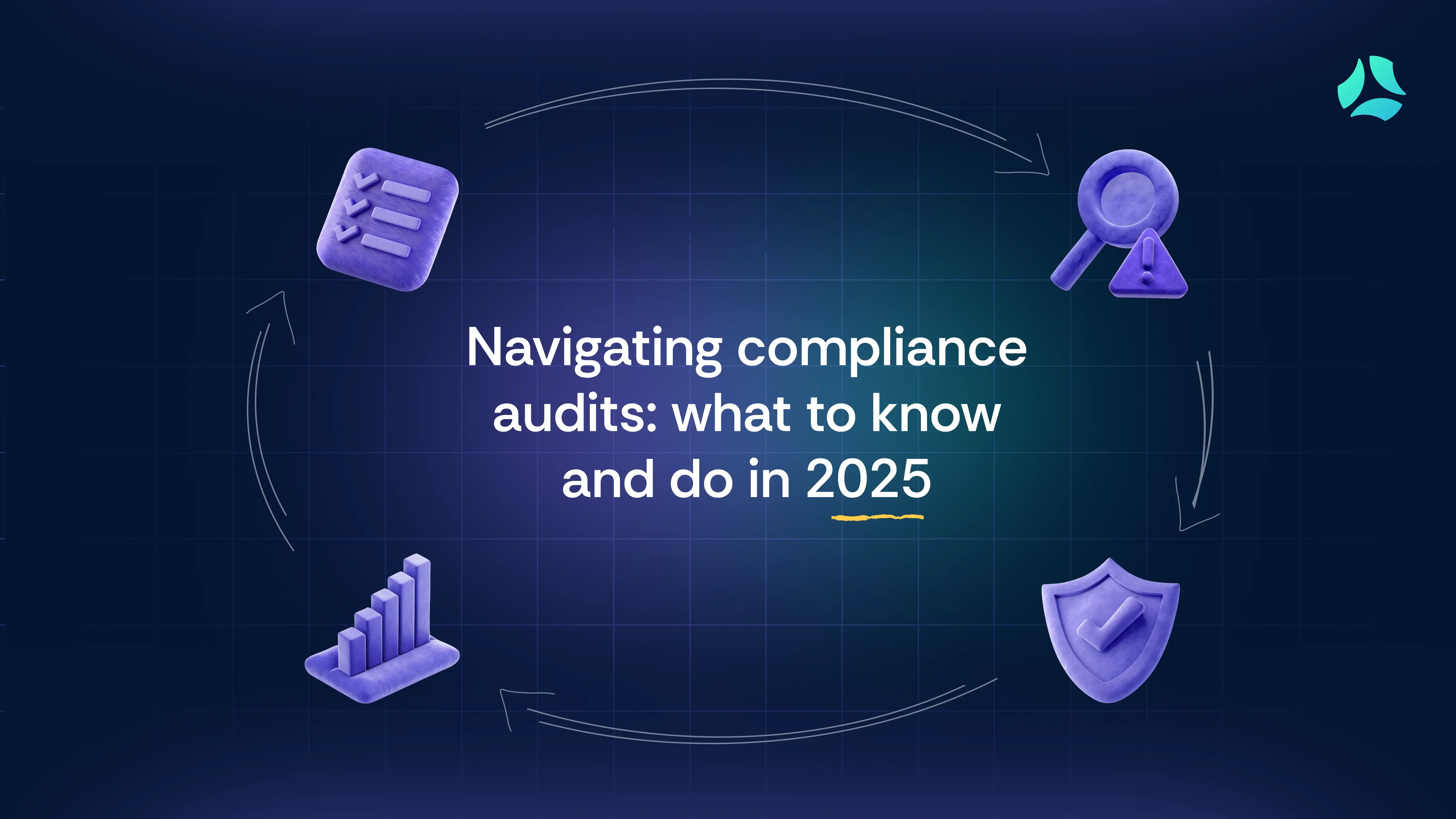CPRA Regulations: Unraveling the California Privacy Rights Act

In a world fueled by digital innovation, the need to safeguard personal information has taken center stage. Enter the California Privacy Rights Act (CPRA regulations), a pivotal response to the pressing need for robust data protection in an era of rapid technological advancement.
The California Consumer Privacy Act (CCPA) laid the groundwork for data privacy regulations in the state of California. Building upon the principles set by the CCPA, the CPRA embarks on an exciting journey to reinforce consumer rights, fortify data protection, and introduce novel provisions to ensure a secure digital landscape.
At its heart, CPRA is designed to empower individuals by providing them with greater control over their personal data. It introduces an enforcement agency dedicated to monitoring compliance and broadens its jurisdiction to encompass sensitive data categories.
Stay tuned as we dive into each facet of the California Privacy Rights Act, uncovering its far-reaching implications, the roadmap to compliance, and the transformative impact it promises to have on the landscape of data privacy.
The evolution from CCPA to CPRA regulations
The CCPA is the guardian of CPRA's principles. Tasked with enforcing the CPRA and championing consumer privacy rights, the CPPA wields investigative and enforcement powers. Its emergence signifies a strong commitment to upholding the standards of data privacy.
The transition from CCPA to CPRA regulations signifies a pivotal shift in data privacy regulation. In terms of differences between CCPA vs CPRA, CPRA builds upon CCPA's foundation to create a more comprehensive framework, extending rights and protections for consumers. It introduces new categories of personal information and expands the scope to include data sharing.
Stricter guidelines for children's data and biometric information reflect evolving privacy concerns. CPRA's enforcement agency enhances oversight, imposing stricter penalties for violations. This evolution showcases California's commitment to adapting regulations in an ever-changing digital environment.
Revisions under the California Privacy Rights Act 2023: CPRA vs CCPA
CPRA takes consumer rights to new heights, granting individuals unprecedented control over their personal information. It offers the right to rectify inaccurate data, limits the use of sensitive data, and provides the ability to opt out of specific data-sharing practices. This shift places individuals firmly in charge of their valuable data assets.
CPRA regulations isn't merely an extension of CCPA; it's a leap forward. It introduces novel rights, including the fascinating "right to know" about automated decisions made using personal data and the empowering "right to limit" sharing of personal information.
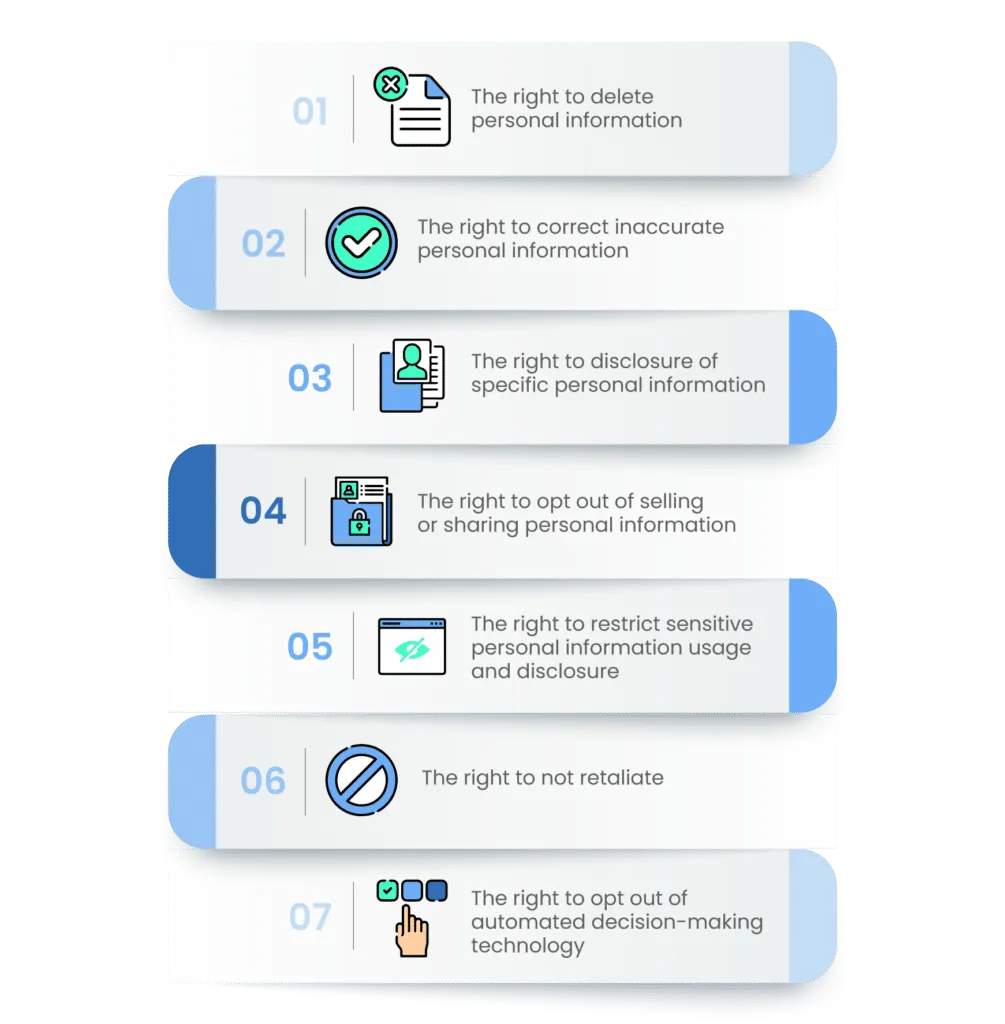
1. The right to delete personal information
Under the CCPA, customers can request the removal of their data from business systems, prompting companies to erase the data upon receiving valid requests.
CPRA mandates businesses to inform service providers, contractors, and third parties to whom consumer data has been sold or transferred—unless deemed impractical or excessively demanding.
Further, each service provider must cascade the request for consumer data deletion to downstream providers.
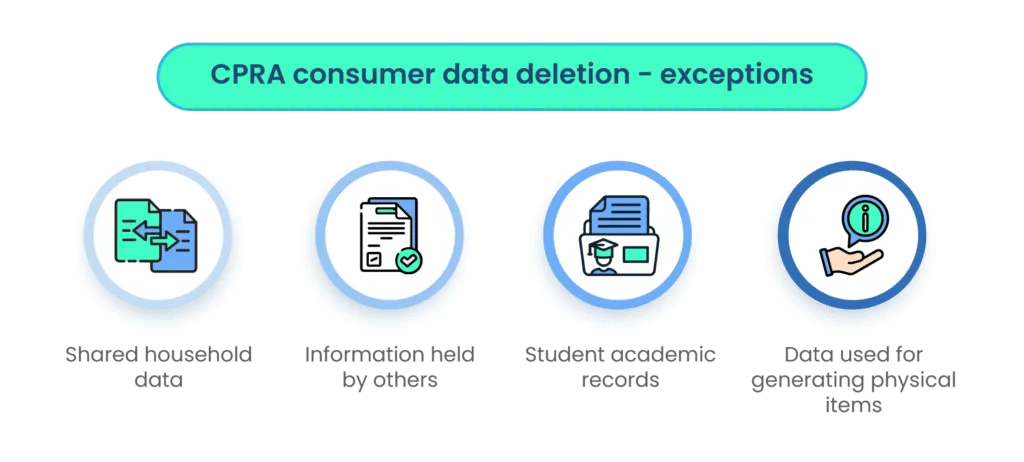
CPRA introduces exceptions to this requirement, relieving organizations from deleting:
- Household data shared by individuals residing at the same address.
- Personal information maintained by another person.
- Student information like grades, test scores, or educational data held on behalf of a local education organization.
- Specific information approved for generating physical items (e.g., yearbooks).
2. The right to correct inaccurate personal information
CPRA regulations introduces the consumer's right to rectify incorrect personal information. Businesses must facilitate this correction, acknowledging the customer's right as articulated in privacy notices.
Upon verified requests for correction, businesses must make 'commercially reasonable efforts' to rectify the inaccuracies according to consumer specifications and established regulations.
3. The right to disclosure of specific personal information
CCPA allows consumers to inquire about the treatment of collected personal information, including its categories, sources, purposes, and third-party sharing.
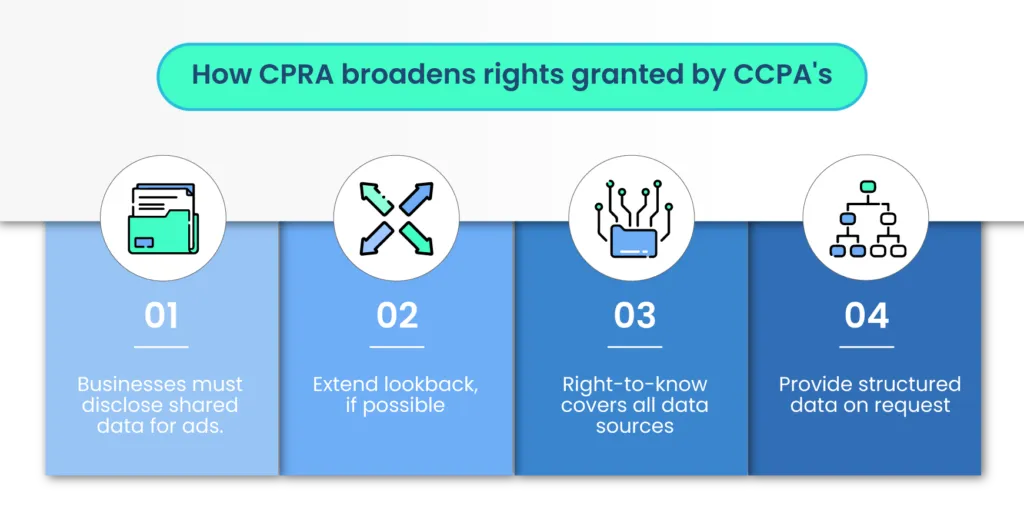
CPRA enhances and broadens these rights by:
- Mandating businesses to divulge personal information shared with third parties for cross-contextual advertising.
- Expanding the lookback period beyond 12 months if feasible.
- Clarifying that the right-to-know covers data obtained directly/indirectly, including via service providers or contractors.
- Ensuring the provision of specified personal information in a structured, machine-readable format upon consumer request.
4. The right to opt out of selling or sharing personal information
CPRA extends the existing opt-out provision to include both the sale and "sharing" of personal data. Sharing refers to the transfer of consumer data for cross-context advertising to third parties.
The CPRA broadens the existing opt-out provision to encompass the sale and “sharing" of personal information. The CPRA defines sharing as “the transfer or making available by the business of a consumer's personal information to a third party for cross-context advertising."
The business shall not sell or disclose a consumer's personal information under the age of 16 unless the consumer (for consumers over the age of 13) or the consumer's parent (for consumers under the age of 13) has expressly allowed the sale or sharing.
5. The right to restrict sensitive personal information usage and disclosure
CPRA regulations introduces a robust shield around sensitive personal information. Consumers now possess the right to restrict how businesses use and disclose their sensitive data.
In the realm of "sensitive personal data" under CPRA, information like Social Security numbers, driver's license numbers, and biometric data takes center stage.
Recognizing the potential for greater harm if compromised, CPRA regulations devotes special attention to safeguarding this category of data.
This pivotal provision empowers individuals to exercise greater control over their most personal information, including data related to health, finances, race, and more.
By exercising this right, consumers can curtail the potential misuse of their sensitive data, enhancing privacy and data protection in the digital age.
6. The right to not retaliate
CPRA bolsters consumer protection by introducing the right to non-retaliation. This means businesses are prohibited from penalizing or retaliating against consumers who exercise their rights under CPRA regulations.
Whether a consumer requests data access, correction, deletion, or any other CPRA-mandated right, businesses must respect these choices without adverse consequences.
This provision ensures that individuals can confidently and fearlessly assert their data privacy rights, fostering a culture of trust and compliance.
7. The right to opt out of automated decision-making technology
Automated decisions, powered by algorithms and technology, are becoming increasingly common. However, CPRA acknowledges the potential risks of such decisions to individuals.
Consumers now possess the right to opt out of automated decision-making technology, which includes algorithms determining significant aspects of their lives, such as credit scores, job opportunities, and more.
This empowers consumers to retain control over decisions that impact them, striking a balance between technological advancement and personal autonomy.
Who does CPRA regulations apply to?
CPRA regulations applies to the following organizations:
- Businesses that collect and process personal information of California residents and meet certain revenue or data sharing thresholds.
- Entities that control or are controlled by such businesses and share common branding.
This expansive reach ensures that those involved in data processing uphold the same level of data protection standards.
Unpacking CPRA compliance requirements
Now, let's delve into the key aspects of CPRA compliance that set it apart from CCPA.
We'll explore the importance of regular risk assessments, the concept of data minimization, and the implications of data retention limits.
Understanding these nuances is essential for businesses seeking to navigate the evolving world of data privacy effectively.
1. How CPRA compliance differs from CCPA
CPRA isn't just an encore of CCPA; it's a revolution. While CCPA marked a significant step forward, CPRA elevates the game. CPRA amplifies consumer rights, introducing more intricate provisions and establishing the California Privacy Protection Agency (CPPA) to ensure rigorous enforcement. This dynamic shift means businesses must recalibrate their compliance strategies to stay in sync with CPRA's heightened standards.
2. Regular risk assessments and data minimization
CPRA mandates a new normal: the routine assessment of risks lurking within data ecosystems.
Regular risk assessments are now the cornerstone of compliance, compelling businesses to scan for vulnerabilities, anticipate threats, and fortify defenses.
Simultaneously, CPRA advocates for data minimization—reducing data collection to essentials and safeguarding privacy by design.
3. Data retention limits and their implications
CPRA ushers in a new era of data retention. It mandates that businesses retain personal information only for as long as necessary.
This means streamlining data storage practices, bidding adieu to outdated records, and curbing the temptation to hoard data. By embracing data retention limits, businesses create leaner, more privacy-centric data landscapes.
Impact on business operations
The California Privacy Rights Act (CPRA) is reshaping business operations, requiring companies to prioritize data protection, transparency, and user consent to meet its stringent compliance standards.
Businesses are navigating a new terrain under the CPRA, where compliance demands heightened data security, transparency, and a privacy-centric approach in all aspects of their operations.
1. Addressing data security under CPRA regulations
Under CPRA's watchful eye, data security becomes paramount. Businesses must implement robust security measures that align with industry standards.
Encryption, access controls, and employee training surge in significance as CPRA calls for airtight data protection. The goal is to shield personal data from prying eyes and potential breaches.
2. Navigating data handling practices for compliance
With CPRA's stringent requirements, the tides of data handling practices are shifting. Consent mechanisms must be crystal clear, and data sharing practices must be transparent. Businesses must weave compliance into every thread of data interaction, from collection to deletion. This transformation ensures a privacy-first approach that respects user choices.
3. Building consumer trust amidst stricter regulations
Amidst the landscape reshaped by CPRA regulations, consumer trust reigns supreme. Businesses that embrace CPRA demonstrate their commitment to safeguarding personal data, fostering a transparent environment. By embodying CPRA's principles, businesses can inspire trust, loyalty, and a sense of security among consumers.
Steps to prepare for CPRA regulations
As the CPRA ushers in a new era of data protection and privacy rights, businesses must proactively adapt to meet its stringent requirements.
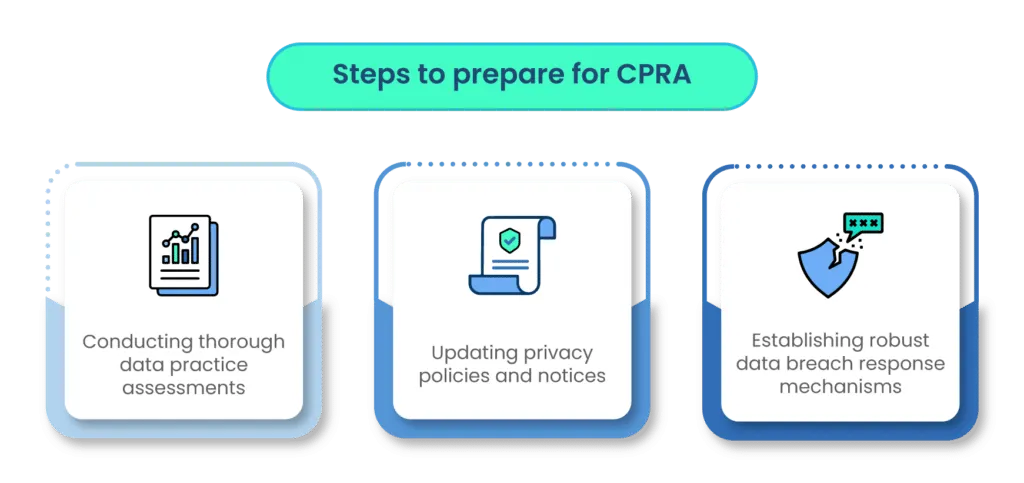
To successfully navigate the CPRA landscape, organizations should embark on a journey that encompasses three critical steps:
1. Conducting thorough data practice assessments
Embarking on CPRA compliance demands a comprehensive self-evaluation. Scrutinize your data practices with a discerning eye. Identify what data you collect, how you use it, and where it flows.
Uncover vulnerabilities, assess risks, and pinpoint areas that need bolstering. This introspective journey lays the foundation for a resilient CPRA strategy.
2. Updating privacy policies and notices
Under CPRA's spotlight, transparency is non-negotiable. Revamp your privacy policies and notices to align with CPRA's intricate requirements. Craft clear, concise disclosures that empower users to make informed decisions.
Highlight data categories, sharing practices, and rights available to users. By elevating transparency, you build trust with users.
3. Establishing robust data breach response mechanisms
In a data-driven world, breaches can't be ruled out entirely. But your response can define the aftermath. Establish airtight data breach response protocols.
Outline steps to swiftly contain breaches, notify affected parties, and liaise with the CPPA where necessary. A well-oiled response mechanism is your compass in the storm.
CPRA's role in shaping data privacy
CPRA's impact ripples across industries and affects the trajectory of data protection on a global scale.
A milestone in privacy legislation
CPRA's emergence isn't just another chapter; it's a landmark in the narrative of data privacy. With its consumer-centric stance and stringent compliance measures, CPRA sets new benchmarks that echo beyond California's borders. Its ripples impact the trajectory of data protection globally.
Implications for businesses and individuals
CPRA's far-reaching implications extend to both businesses and individuals. For businesses, CPRA translates to recalibrating practices, fostering consumer trust, and embracing a culture of compliance. For individuals, it signifies enhanced control over personal data, greater transparency, and the assurance of robust privacy safeguards.
The path towards enhanced data security and transparency
CPRA's journey is one of transformation. It paves the way for a future where data security and privacy aren't just buzzwords; they're fundamental values.
As businesses and individuals alike adapt to CPRA's demands, a new norm emerges, one defined by responsible data handling, resilient privacy measures, and a shared commitment to securing data.
A new standard of data ethics
The California Privacy Rights Act (CPRA) has ignited a transformation in the way we approach data privacy.
With its groundbreaking provisions, CPRA reshapes the landscape, ushering in an era where personal data is treated with the utmost respect and protection. This isn't just compliance; it's a commitment to a new standard of data ethics.
An ongoing journey of data privacy protection
CPRA isn't a destination; it's a journey of continuous improvement. As information flows across borders and technologies evolve, safeguarding personal data remains an ever-evolving endeavor.
CPRA regulations acts as a sentinel, adapting and enhancing data privacy safeguards. It propels businesses to proactively align strategies with changing regulatory currents, shaping a future where personal information is revered, secured, and controlled.
This journey necessitates continual learning, collaboration, and innovation to build a resilient shield against cyber threats while empowering individuals with privacy rights.
Consequences of non-compliance with the CPRA regulations
Non-compliance with the CPRA can lead to significant consequences for businesses. These may include:
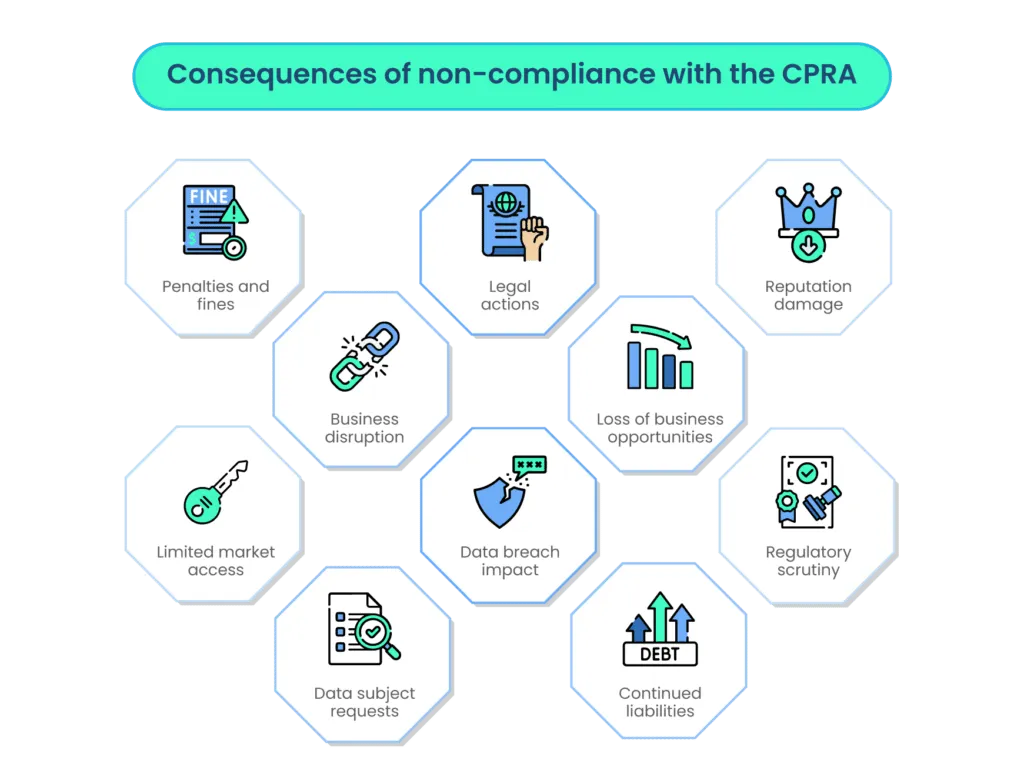
- Penalties and fines: CPRA introduces increased fines for violations, potentially resulting in substantial financial penalties for non-compliant organizations.
- Legal actions: Non-compliance may expose businesses to legal actions, including class-action lawsuits by affected individuals or groups.
- Reputation damage: Violations of data privacy regulations can damage a company's reputation and erode consumer trust, impacting long-term relationships and brand value.
- Business disruption: Regulatory authorities may impose corrective actions that disrupt normal business operations, leading to operational challenges and additional costs.
- Loss of business opportunities: Non-compliance might result in businesses losing partnerships, contracts, or opportunities with organizations that prioritize compliant data handling.
- Limited market access: Some industries or markets may require strict compliance, limiting access for non-compliant businesses to certain sectors.
- Data breach impact: Failure to implement adequate data protection measures increases the risk of data breaches, potentially causing further financial and reputational damage.
- Regulatory scrutiny: Non-compliance can trigger regulatory investigations and audits, subjecting the organization to increased scrutiny.
- Data subject requests: Non-compliance may lead to challenges in fulfilling data subject rights requests, potentially resulting in complaints and legal actions.
- Continued liabilities: Even after non-compliance, businesses may still be held accountable for rectifying violations and addressing their consequences.
To avoid these consequences, businesses should prioritize understanding CPRA requirements, implementing necessary changes, and collaborating with compliance professionals, like Scrut, to ensure full adherence.
Wrapping up: Charting the course ahead
CPRA regulations isn't just about checkboxes and regulations; it's about redefining the relationship between individuals, businesses, and their data.
Embracing CPRA offers businesses a competitive advantage by building consumer trust while individuals regain ownership of their personal information
Learn more about CPRA and how it may affect your business by talking to industry leaders in compliance. Schedule a free demo with Scrut here.
FAQs
1. What is the California Privacy Rights Act (CPRA) and why was it introduced?
The California Privacy Rights Act (CPRA) is a data privacy law aimed at enhancing consumer privacy rights. It was introduced to strengthen data protection measures, give consumers more control over their personal information, and address gaps in the previous law, the CCPA.
2. What are the main differences between CPRA and CCPA?
CPRA builds upon the California Consumer Privacy Act (CCPA) by introducing new rights like the right to correct inaccurate personal information, the establishment of a dedicated enforcement agency, and provisions related to sensitive personal data.
3. Who does the CPRA apply to, and what kind of data does it protect?
CPRA applies to businesses that collect or process the personal information of California residents and meet certain criteria. It protects various categories of personal data, including sensitive information like Social Security numbers, financial account numbers, and health information.
4. How does CPRA impact businesses and their compliance efforts?
CPRA imposes stricter obligations on businesses, requiring them to implement additional security measures, conduct regular risk assessments, and adhere to new data retention limitations. Businesses need to reassess their data handling practices to ensure compliance.
5. What steps should businesses take to prepare for CPRA regulations compliance?
Businesses should begin by assessing their current data collection and processing practices. They need to implement robust security measures, update their privacy policies, and establish procedures to address consumer requests and data breaches. Seeking legal guidance and staying informed about CPRA updates is also crucial for successful compliance.




